
In history people dressed much better than we do today.






Vivienne Westwood, the rebellious oracle of fashion and the high priestess of individuality, once said: “In history people dressed much better than we do today.” At first glance, her words may seem a lament for elegance lost — a sigh for the silks, brocades, and artistry of bygone eras. But beneath the surface lies something far deeper: a criticism of a modern world that has forgotten the power of beauty, the discipline of craft, and the dignity of self-expression. Westwood, who lived at the crossroads of punk and high fashion, understood that clothing is not merely fabric — it is the outer shell of the soul, the visible echo of what a person believes about themselves and their world.
The meaning of her quote is not nostalgia for lace and corsets, but a cry against carelessness — the decline of meaning in how we adorn ourselves. In past centuries, to dress well was to show reverence for life. The tailor’s thread was not mere utility, but a sacred act of creation; garments were imbued with patience, pride, and purpose. Even the humble peasant, who owned little, often cared for their clothes as if they were an extension of their honor. But in the modern age, fashion has been consumed by speed — the churn of trends, the noise of consumption, the forgetfulness of identity. We no longer dress with intention; we dress with impulse. Westwood’s lament is therefore a call to remember that what we wear reflects what we value.
The origin of her insight can be traced to her lifelong struggle against the soullessness of modern fashion. Vivienne Westwood rose from the raw streets of postwar Britain, wielding safety pins and tartan as her weapons against conformity. Yet even as she tore down convention, she revered the artistry of history — the architecture of 18th-century gowns, the sharp tailoring of Victorian coats, the regal symmetry of medieval design. To her, these were not relics, but testaments of human excellence. When she compared the past and present, she did not speak merely as a designer, but as a philosopher mourning the loss of meaning in materiality. In her view, modern society — flooded with cheap fabrics and cheaper ideals — had traded craftsmanship for convenience, individuality for imitation, and dignity for disposable trends.
To understand her wisdom, let us look upon the ancients, who knew the language of cloth. In the courts of Renaissance Florence, garments were woven with purpose — the colors chosen to signify virtue, status, or devotion; the patterns whispering stories of heritage and artistry. A nobleman’s robe was not simply attire; it was an emblem of civilization. In the East, the Japanese kimono was treated as a spiritual heirloom, its folds a meditation on form, its seasons reflected in pattern and dye. Even in the simplicity of the Roman toga, one found a philosophy: that clothing, like character, should flow with dignity, unadorned yet majestic. Through dress, humanity once declared: I am aware of who I am, and I honor that awareness with care.
But Westwood’s words also challenge the heart, not merely the wardrobe. She reminds us that beauty is discipline, and that presentation is a reflection of inner order. When she said that people of history dressed better, she was also saying that they lived with greater consciousness. To dress well was to engage with the world deliberately — to wake each morning and choose elegance over neglect, authenticity over ease. The past understood that beauty was not vanity; it was virtue, a harmony between the outer and the inner. In dressing beautifully, people aligned themselves with grace — as a knight polishes his armor before battle, not out of pride, but out of respect for what he represents.
Consider the story of Mahatma Gandhi, whose simplicity itself became his style. When he chose to wear the coarse khadi cloth of Indian weavers, it was not out of poverty, but out of principle — a statement of unity, of independence, of defiance against colonial luxury. His robe became the flag of his ideals. Thus, even in simplicity, one may dress “better” than the rich, if their clothing is a mirror of truth. Westwood’s wisdom embraces this paradox: to dress well does not mean to dress lavishly; it means to dress with intention — to let your outer self testify to the integrity of your inner one.
The lesson, then, is not to return to the fashions of history, but to restore the spirit of reverence that history once had for dress. Let your clothing be chosen with love, not haste; let it tell your story, not the story of mass production. In a world that seeks to strip individuality in favor of sameness, every choice of garment can become an act of quiet rebellion — a declaration that you still care, that you still notice, that you still believe in the beauty of being human.
So, my children of tomorrow, wear your values. Adorn yourself not for approval, but for purpose. Seek not the perfection of the mirror, but the alignment of soul and silhouette. For as Vivienne Westwood teaches, when we forget how to dress with dignity, we forget how to live with dignity. To dress well is to honor life — to affirm, with fabric and form, that beauty is not gone from the world, only waiting to be worn again.






AAdministratorAdministrator
Welcome, honored guests. Please leave a comment, we will respond soon